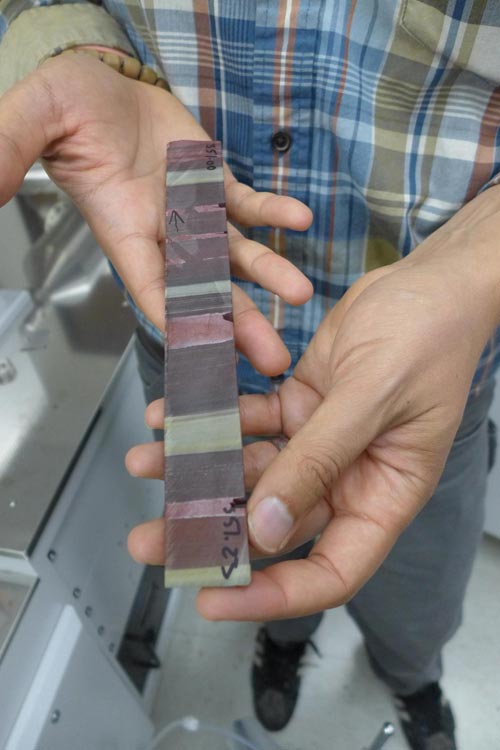Ancient rocks record first evidence for photosynthesis that made oxygen

Aaron Satkoski, a scientist in the UW-Madison Geoscience Department, holds a sample sawn from a 3.23-billion-year-old rock core sample found in South Africa. The bands show different types of sediment falling to the ocean floor and solidifying into rock. The sample provides the earliest known evidence for oxygenic photosynthesis. Credit: David Tenenbaum/University of Wisconsin-Madison
“Rock from 3.4 billion years ago showed that the ocean contained basically no free oxygen,” says Clark Johnson, professor of geoscience at UW-Madison and a member of the NASA Astrobiology Institute.
“Recent work has shown a small rise in oxygen at 3 billion years. The rocks we studied are 3.23 billion years old, and quite well preserved, and we believe they show definite signs for oxygen in the oceans much earlier than previous discoveries.”
The most reasonable candidate for liberating the oxygen found in the iron oxide is cyanobacteria, primitive photosynthetic organisms that lived in the ancient ocean. The earliest evidence for life now dates back 3.5 billion years, so oxygenic photosynthesis could have evolved relatively soon after life itself.
Until recently, the conventional wisdom in geology held that oxygen was rare until the “great oxygenation event,” 2.4 to 2.2 billion years ago.
The rocks under study, called jasper, made of iron oxide and quartz, show regular striations caused by composition changes in the sediment that formed them. To detect oxygen, the UW-Madison scientists measured iron isotopes with a sophisticated mass spectrometer, hoping to determine how much oxygen was needed to form the iron oxides.
“Iron oxides contained in the fine-grained, deep sediment that formed below the level of wave disturbance formed in the water with very little oxygen,” says first author Aaron Satkoski, an assistant scientist in the Geoscience Department. But the grainier rock that formed from shallow, wave-stirred sediment looks rusty, and contains iron oxide that required much more oxygen to form.
The visual evidence was supported by measurements of iron isotopes, Satkoski said.
The study was funded by NASA and published in Earth and Planetary Science Letters.
The samples, provided by University of Johannesburg collaborator Nicolas Beukes, were native to a geologically stable region in eastern South Africa.
Because the samples came from a single drill core, the scientists cannot prove that photosynthesis was widespread at the time, but once it evolved, it probably spread. “There was evolutionary pressure to develop oxygenic photosynthesis,” says Johnson. “Once you make cellular machinery that is complicated enough to do that, your energy supply is inexhaustible. You only need sun, water and carbon dioxide to live.”
Other organisms developed forms of photosynthesis that did not liberate oxygen, but they relied on minerals dissolved in hot groundwater — a far less abundant source than ocean water, Johnson adds. And although oxygen was definitely present in the shallow ocean 3.2 billion years ago, the concentration was only estimated at about 0.1 percent of that found in today's oceans.
Confirmation of the iron results came from studies of uranium and its decay products in the samples, says co-author Brian Beard, a senior scientist at UW-Madison. “Uranium is only soluble in the oxidized form, so the uranium in the sediment had to contain oxygen when the rock solidified.”
Measurements of lead formed from the radioactive decay of uranium showed that the uranium entered the rock sample 3.2 billion years ago. “This was an independent check that the uranium wasn't added recently. It's as old as the rock; it's original material,” Beard says.
“We are trying to define the age when oxygenic photosynthesis by bacteria started happening,” he says. “Cyanobacteria could live in shallow water, doing photosynthesis, generating oxygen, but oxygen was not necessarily in the atmosphere or the deep ocean.”
However, photosynthesis was a nifty trick, and sooner or later it started to spread, Johnson says. “Once life gets oxygenic photosynthesis, the sky is the limit. There is no reason to expect that it would not go everywhere.”
###
–David Tenenbaum, 608-265-8549, djtenenb@wisc.edu
DOWNLOAD PHOTO: https:/
Media Contact
All latest news from the category: Earth Sciences
Earth Sciences (also referred to as Geosciences), which deals with basic issues surrounding our planet, plays a vital role in the area of energy and raw materials supply.
Earth Sciences comprises subjects such as geology, geography, geological informatics, paleontology, mineralogy, petrography, crystallography, geophysics, geodesy, glaciology, cartography, photogrammetry, meteorology and seismology, early-warning systems, earthquake research and polar research.
Newest articles

First-of-its-kind study uses remote sensing to monitor plastic debris in rivers and lakes
Remote sensing creates a cost-effective solution to monitoring plastic pollution. A first-of-its-kind study from researchers at the University of Minnesota Twin Cities shows how remote sensing can help monitor and…

Laser-based artificial neuron mimics nerve cell functions at lightning speed
With a processing speed a billion times faster than nature, chip-based laser neuron could help advance AI tasks such as pattern recognition and sequence prediction. Researchers have developed a laser-based…

Optimising the processing of plastic waste
Just one look in the yellow bin reveals a colourful jumble of different types of plastic. However, the purer and more uniform plastic waste is, the easier it is to…



